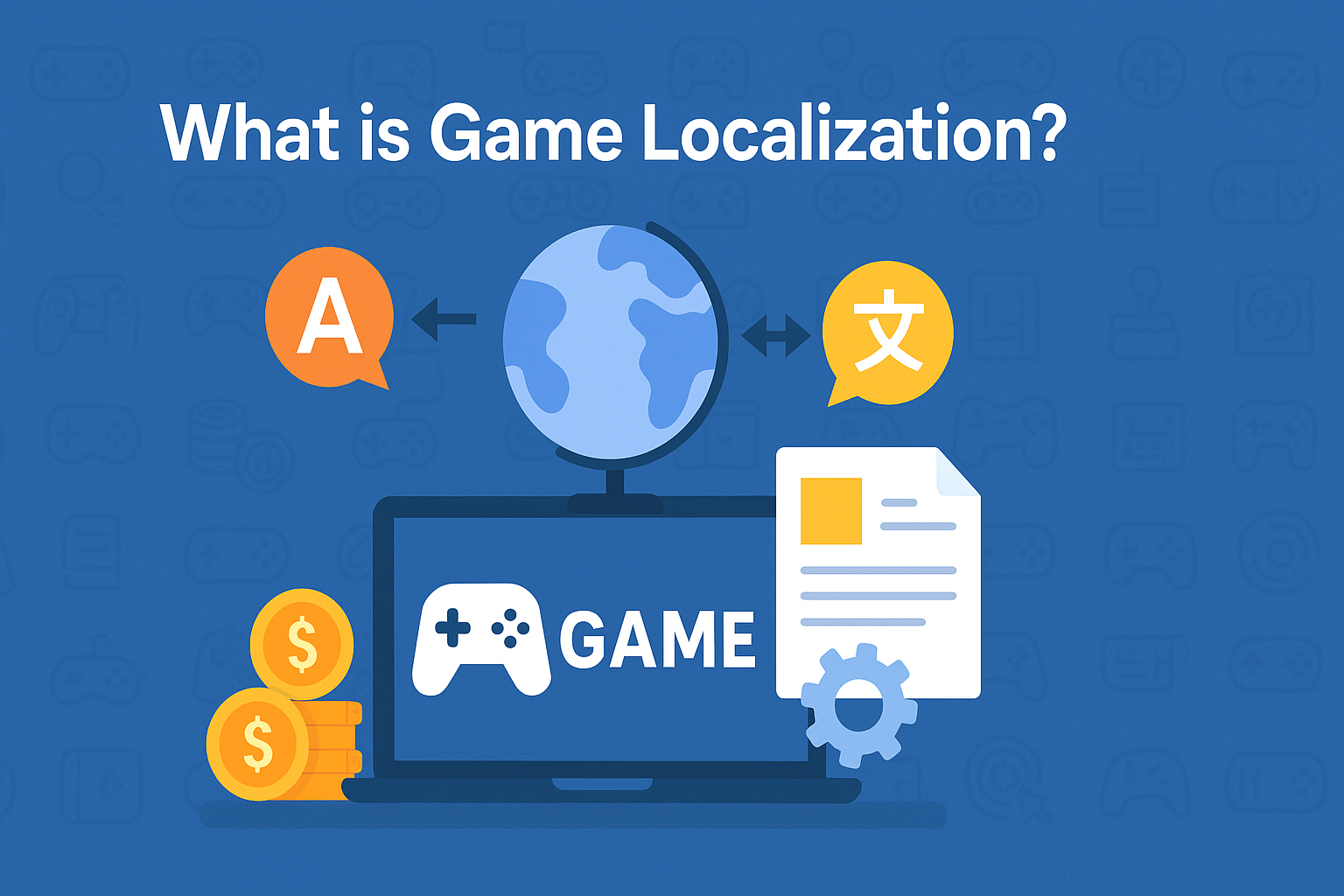Game localization is the process of adapting a video game for different languages, cultures, and regions to make it feel native to players worldwide. Unlike mere translation, game localization involves cultural adaptation of everything from text and voiceovers to graphics, character names, jokes, and even game mechanics. Its goal is to preserve the original experience while ensuring it resonates naturally with local audiences. As the global gaming industry becomes increasingly competitive, game developers rely on localization to expand their reach and build loyal fan bases in diverse markets.
What is the Difference Between Localisation and Translation?
While the terms are often used interchangeably, localisation and translation are not the same. Translation is the literal conversion of text from one language to another. It focuses on language accuracy. Localisation, on the other hand, goes a step further. It adjusts idioms, cultural references, time formats, currencies, and even visual elements to suit the target audience.
In the context of the localization of video games, this means modifying content to suit regional preferences and expectations. For example, a joke that works in the U.S. may fall flat or be misunderstood in Japan. Similarly, colors, gestures, or symbols that are acceptable in one culture may be offensive in another. Localization ensures that games are not only understood, but also enjoyed as intended – regardless of the player’s background.
What are the Benefits of Video Game Localization?
Investing in video game localisation offers a range of strategic benefits:
- Wider Market Reach: Games that are localized can be sold in multiple regions, significantly increasing potential revenue.
- Stronger Brand Loyalty: Players are more likely to connect with a game that reflects their culture and language, resulting in longer engagement and higher lifetime value.
- Competitive Advantage: In saturated markets, localization can be a key differentiator, helping games stand out.
- Better Reviews & Ratings: Players tend to leave positive feedback when games are well-localized, which in turn improves visibility in app stores and marketplaces.
- Increased Sales of DLCs and In-Game Purchases: Localization ensures monetization strategies work across regions, not just in the game’s home country.
For mobile developers, mobile game localization is especially crucial, as app stores cater to a global user base. A game localized in 10+ languages often ranks higher and gets featured more frequently.
Game Localization Examples
Some standout game localization efforts have reshaped the global success of franchises:
- The Witcher series: Originally developed in Poland, this RPG franchise saw massive success due to its deep and immersive localization into dozens of languages, with voice acting and dialogue tailored for each culture.
- Pokémon: With careful localization of names, abilities, and cultural references, Pokémon became a global phenomenon while maintaining its core appeal.
- Animal Crossing: New Horizons: Nintendo adapted holidays, sayings, and even character designs for different markets.
- Genshin Impact: This Chinese-developed game gained a worldwide audience thanks to simultaneous voiceover recording and cultural adaptation across multiple regions.
These examples prove that investing in a high-quality game localization service can directly lead to increased popularity and commercial success.
Key Game Localization Challenges

While rewarding, game localization comes with its own set of difficulties:
- Contextual Ambiguity: Translators often work with strings of text out of context, leading to mistranslations. Without gameplay footage or dev notes, even the best translators can struggle.
- Character Constraints: Languages vary in length. German phrases are often longer than their English counterparts, while Chinese is more concise. This creates UI/UX issues, especially on mobile devices.
- Voiceover & Lip-syncing: Adapting spoken dialogue to match animations is time-consuming and expensive, particularly for AAA games.
- Cultural Sensitivities: What’s funny or acceptable in one culture may be controversial in another. Missteps can lead to backlash and bad PR.
- Technical Integration: Developers must ensure that translated content fits properly into the game’s framework. Placeholder tags, code strings, and hardcoded text all need attention.
Moreover, costs associated with localization – such as hiring native linguists, voice actors, QA testers, and integrating localized builds – can be significant. However, with the right planning and a professional localization of game service, these challenges can be effectively managed.
Game Localization Process: Step-by-Step
To ensure a smooth and effective localization workflow, most developers follow a structured multi-phase process. Here’s how it typically works:
1. Preparation and Internationalization
Before localization even begins, the game must be internationalized. This means designing the game’s architecture in a way that supports multiple languages and regional differences. Developers must:
- Separate text from code.
- Avoid hardcoded strings.
- Use Unicode (UTF-8) to support diverse characters.
- Design UI that adapts to different text lengths and directions (e.g., right-to-left languages like Arabic and Hebrew).
2. Asset Extraction
Text, voice files, UI elements, icons, and cultural references are extracted and documented. Creating a localization kit that includes context, variables, and character limits ensures translators understand the full scope.
3. Translation and Adaptation
This is where the magic happens. Professional linguists – preferably gamers themselves – translate not just the words but the experience. They adapt slang, humor, idioms, and cultural references. This is particularly important in localization of video games where immersion is key.
Some companies use machine translation to speed up the process, but human review is essential. For complex RPGs, narratives must flow naturally, with consistent terminology across quests, NPC dialogues, and in-game lore.
4. Culturalization
This step goes beyond translation. Culturalization involves removing or adapting content that may be offensive or misunderstood in different markets. Examples include:
- Changing religious symbols or politically sensitive content.
- Altering blood and violence levels to meet age ratings.
- Replacing food, gestures, or holidays with locally relevant ones.
5. Voiceover Recording and Sync
If the game includes voice acting, voiceover localization is another massive undertaking. Matching tone, emotion, and timing in another language – while syncing with existing animations – requires experienced voice directors and actors.
6. Integration and Testing
Once all assets are localized, they’re reintegrated into the game build. Then comes LQA (Localization Quality Assurance) – a critical step often overlooked.
LQA testers play the game in its localized form to catch bugs, visual issues, font problems, broken characters, audio mismatches, and translation inconsistencies. It’s not just proofreading – it’s full linguistic gameplay testing.
7. Launch and Ongoing Updates
Post-launch support is essential, especially for online games and DLCs. A good game localization service includes ongoing support for updates, patches, live events, and community feedback.
How Mobile Game Localization Differs
While the core process remains similar, mobile game localization introduces specific challenges and opportunities:
- App Store Optimization (ASO): Titles, descriptions, and keywords must be localized for Apple App Store and Google Play to ensure discoverability.
- Shorter Sessions, Shorter Strings: Mobile games often rely on concise UI and fast gameplay, meaning translations must be efficient and impactful.
- Frequent Updates: Mobile games release updates more often than console or PC games, so localization must be agile and scalable.
- Monetization Models: In-app purchases, ads, and subscriptions must be adapted for regional pricing and user behavior.
Game Localization Costs: What to Expect
The costs of game localization vary widely depending on the scope, number of languages, and level of complexity. Here’s a breakdown of common cost factors:
| Factor | Cost Impact |
| Number of words | More text = higher cost |
| Number of languages | Per-language rates apply |
| Voiceover localization | High-cost, especially for AAA games |
| LQA and testing | Additional but essential |
| Project management | Coordination adds overhead |
| Tools & tech stack | CAT tools, TMS, and APIs may have fees |
For indie developers, costs can range from $1,000 to $10,000 for basic translation and integration. For AAA titles or live-service games with voice acting and cinematics, localization budgets can exceed $500,000.
However, it’s important to view localization as an investment, not an expense. Games that localize into the top 10 global languages – like Chinese, Spanish, Japanese, French, German, Korean, Russian, Portuguese, Italian, and Arabic – see a dramatic increase in market size and revenue potential.
Choosing the Right Game Localization Service
Not all localization vendors are created equal. When selecting a game localization service, consider:
- Experience with games: Agencies that specialize in games understand tone, pacing, and cultural nuance better than general translation firms.
- Use of technology: Does the vendor support integrations with Unity, Unreal Engine, or GitHub? Do they use a Translation Management System (TMS)?
- Scalability: Can they support you if you move from 2 to 20 languages?
- LQA capabilities: Do they offer full testing in context?
- Community management: Can they help localize player support, social media, or community forums?
Crowdin, for example, is a popular localization platform that supports game developers through integrations, automation, and collaborative workflows. It’s particularly useful for developers who release frequent updates and need version control and seamless translation pipelines.
Conclusion
In an era where global gaming is the norm, game localization is not a luxury – it’s a necessity. From nuanced cultural adaptation to technical implementation, localization ensures games are immersive, engaging, and accessible to players worldwide. Whether you’re developing a console title or launching the next hit mobile app, investing in high-quality video game localisation is one of the smartest moves you can make.


